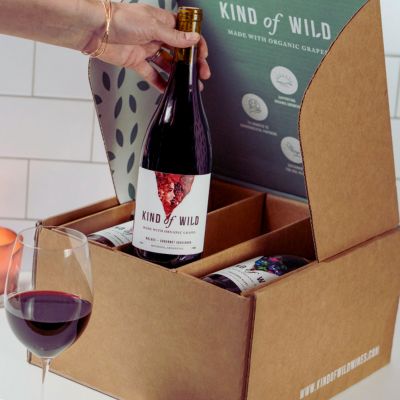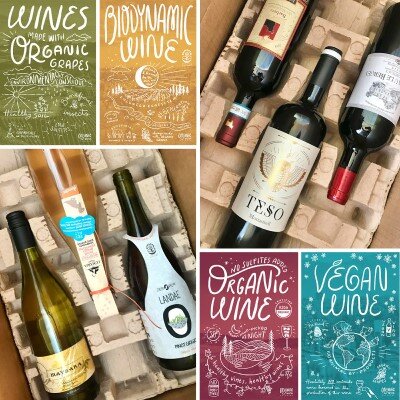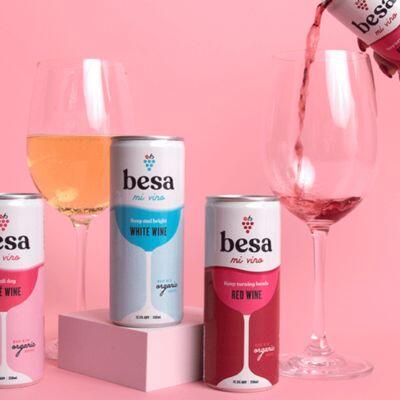TheRoundup is reader supported. We may earn a small commission when you make a purchase via links on this site, at no cost to you.
All products are personally reviewed and tested in accordance with our Review Methodology.

Ah, wine...the beloved beverage of the gods...and Mrs. M (I like it too, but I'm more of a tequila guy).
Whether you're an aspiring wine nerd looking to step up your game or an eco-friendly consumer seeking more bang for your buck, enjoying wines made using organic practices is both healthier and more environmentally friendly!
From light grassy whites to big, bold reds, there are plenty of delicious organic wine brands that won't cost the Earth.
So forget artificial ingredients and over-fertilized grapes. Read on to discover why going green with organic wine is an unforgettable journey you have to try!

✔ Certified Organic & Vegan
✔ 23% Subscribe & Save Discount
✔ Member of 1% for the Planet

When searching for a wine brand that seamlessly combines excellent wine quality and business ethics, I can't find anyone doing it better than Kind of Wild.
Kind of Wild emerged from the vision of Jordan & Adam Sager, who aimed to blend global wine discoveries with a forward-thinking, mission-driven approach to sustainability.
Drawing on 50 years of combined experience in the wine industry through their family importing company, they've formed meaningful relationships with exceptional growers and winemakers worldwide and have grown Kind of Wild into an incredible collection of global wine discoveries dedicated to rewilding the planet.
After launching the brand, fate brought Jordan & Adam together with celebrity chef and television personality Katie Lee Biegel. This encounter marked the beginning of an exciting collaboration that continues to shape the future of Kind of Wild.
Katie soon became a co-founder and an integral part of the team, lending her unique culinary perspective and inspiring creativity.
Together, this impressive partnership is redefining the wine landscape, pushing boundaries, and exceeding expectations. Kind of Wild collaborates with exceptional growers worldwide to produce premium wines free from harmful additives and excessive sugar.
It's also great to know that through the collective efforts of all the partners involved in producing the wine (and us consumers drinking it! 🍷), we enhance soil health, reduce erosion, protect natural waters from harmful chemicals, and leave a positive, lasting impact on local ecosystems.
I also love that Kind of Wild is a 1% for the Planet member, and all its wines are certified organic and vegan.
The certifications carried by Kind of Wild are impressive. But the wine is the undisputed star!
My dad and I love a punchy red with a steak dinner on New Year's Eve (a lovely tradition we've had for decades), and the Kind of Wild Malbec never disappoints!

✔ Organic Certifications
✔ Convenient Wine Club
✔ Wide Range of Options

The Organic Wine Exchange wine clubs are what got Mrs. M into turning out wine list organic in the first place. We both love the convenience of regular deliveries (we currently get a 12-bottle mixed box every quarter). It's like Christmas every three months when the package arrives, and we discover what's inside.
On top of the convenience of regular deliveries, you also get a 100% satisfaction guarantee. If you're sent a wine you don't like, you don't pay for it. Simple as that!
If you'd rather choose your wines, you'll also love the Organic Wine Exchange. They have a wide range of organic and eco-friendly wines to suit all tastes and budgets.
I love how you can search the site for specific terms but also browse for general categories, such as:
If you want to start your organic wine journey, the Organic Wine Exchange is the perfect jumping-off point. It serves as an informative website and sales hub, catering to wine enthusiasts with ethics.
Within the platform, you can seamlessly exchange knowledge with staff and fellow wine community members, explore and discover winemakers, and purchase wines that align with your preferences.


Mrs. M is as far away from a stereotypical 'wine snob' as you can get. She drinks the wine she likes (and matches her eco-ethics), regardless of its container. That's why she's a big fan of Besa Wines.
Many people would shy away from a brand that only sells three varieties (all in cans!), but not Mrs. M! And I'm entirely on board with her on this one.
All three Besa wines are lovely to drink. The organic red is my favorite (especially when drunk at a beach cookout or tailgate party).
Besa is seeking to revolutionize the world of wine, catering to the demands of modern lifestyles. Its organic and vegan canned wines are perfect companions for any occasion, adding a special touch to every moment.
These wines are not certified organic but made using the best natural grapes, organically farmed, and made using ethical/sustainable manufacturing practices. It's about as good as it gets for uncertified wine.
So, say goodbye to corkscrews and indulge in this sustainably grown, smartly packaged, clean wine.
Organic red and white wines (the epitome of sustainability and purity) are made with organic grapes meticulously cultivated in organic vineyards.
These vineyards shun synthetic chemicals, pesticides, and fertilizers, thus preserving the essence of nature in every sip.
Natural crop rotation and composting promote healthy soil and sustainable farming practices at organic vineyards.
This creates a ripple effect, significantly reducing the air and water pollution associated with traditional viticulture.
Organic wines tend to be lower in sugar and calories than conventional wines, making them a better choice if you're watching your diet or suffer from diabetes.
Organic winemaking also uses fewer additives and preservatives, making these wines ideal if you want to limit exposure to these chemicals (due to allergies or sensitivity, for example).
The purity of organic ingredients also leads to less intense hangovers. Which is a blessing as I get older!
Organic wines often have a more intense flavor and aroma profile than mass-produced wine.
These wines often use traditional vinification methods, such as open fermentation processes or aging in oak barrels, which can further enhance the taste and complexity of the wines.
In my experience, they also tend to be made from higher-quality grapes due to the stringent regulations that organic vineyards must adhere to.
Organic wines offer a unique and enjoyable experience for any wine connoisseur (or enthusiastic amateur like Mrs. M!).
When shopping for organic wine in the US, the USDA Organic and CCOF certifications give you peace of mind that your wine is genuinely organic. However, getting certified is often too expensive for small producers, and many excellent uncertified organic vegan wines do exist.
You should also look for certifications showcasing the wine makers' ethical and sustainability credentials, such as 1% for the Planet and Certified B Corporation.
I like to think of biodynamic wine as organic wine's eccentric cousin.
They have the same good-for-the-earth DNA, but biodynamism takes it further, adding a dash of cosmic connection and a sprinkle of lunar love.
It starts with grapes farmed without synthetic pesticides or fertilizers. But here's where things get a bit more celestial.
Biodynamic farming views the winery as one big, interconnected organism, and it follows a planting and harvesting schedule based on the lunar calendar.
But why the moon, you ask? Well, it's all about the 'vibe.' The idea is that everything in the universe is interconnected and gives off a resonance. So, by aligning farming practices with lunar, solar, and even cosmic rhythms, farmers believe they can achieve greater harmony and balance in their vineyards.
In a way, it's like creating a sustainable ecosystem. The focus is on creating a healthy, self-sustaining environment where the vines can thrive. It's a holistic, homeopathic, and, yes, even somewhat spiritual approach to making wine without additives.
Can you tell your organic cabernet sauvignon from your organic Chardonnay?
Below, I've included a quick guide to the five main types of wine to drink (red, white, rosé, sparkling, and sweet).
This is a brief introduction. If you want to expand your knowledge further, I recommend starting with Robert Parker.
How It's Made
Red wines are made by allowing the grape skins to ferment with the juice, which is why they get their deep, ruby color. This process also gives red wines their bolder flavor and tannins.
Grapes Used
How It's Made
Pure as a snowy peak and light as a summer breeze, white wines get their crisp, refreshing character from the absence of grape skins during fermentation.
Unlike their red cousins, the juice from crushed white grapes is separated from the skins, stems, and seeds before fermentation begins, resulting in a lighter, more delicate flavor profile.
Grapes Used
How It's Made
This pretty-in-pink wine is crafted by letting the juice of red grapes mingle with their skins for a short while.
It's like a brief summer fling. Long enough to impart a rosy hue and a tantalizing taste but not long enough to turn it into a full-bodied red.
Grapes Used
How It's Made
To create those delightful little bubbles that dance on your tongue, winemakers use a method called secondary fermentation.
This means they add a dose of sugar and yeast to the wine after the initial fermentation process. These new ingredients get busy, creating carbon dioxide trapped inside the bottle.
The result? A naturally fizzy, delightfully zippy wine.
Grapes Used
How It's Made
The grapes used for sweet wine are left on the vine longer than their dry counterparts, soaking up every ray and turning it into natural sugars.
Once harvested, these sugary morsels undergo fermentation (the magical process where sugar turns into alcohol).
But here's the kicker: fermentation is stopped midway, leaving some sugar behind for sweet wines.
Grapes Used
There is no distinction between organic and non-organic wine other than the cultivation practices and ingredients employed in production. Both variants can offer equally delightful experiences. The decision of which type of wine to buy is entirely subjective, reflecting your personal preferences and ethics.
'Bio' is usually found on bottles of European wine, and the term is often used interchangeably with 'organic.' The European Union has established regulations governing food and beverages described as organic or bio (similar to the USDA in the US).
Some of the finest domestic wines come from California (Napa Valley and Lake County), Oregon (Willamette Valley), and Washington (Naches Heights and Walla Walla Valley).
Mrs Miller also loves the rosé from a small region in France called Duras (close to Bordeaux).
Some winemakers and retailers have started using green tags or labels to denote their commitment to sustainable and biodynamic practices. You should also look for 'Bio' and 'USDA Organic.' Finally, if you're still unsure, ask the seller or manufacturer (whether in person at your shop of choice or online).
Natural wine has minimal added sulfur, yeast, and other additives. This type of wine aims to preserve as much of the original character of the grape's terroir as possible. Natural wines can also be organic or biodynamic (though not all are certified).
Bonterra is renowned in the industry for its commitment to excellence. It was honored with the prestigious "2016 American Winery of the Year" title. It has a wine club, but Mrs. M and I prefer the one at the Organic Wine Exchange.
No matter what style of wine you enjoy (whether it's a rich and robust red or a crisp and refreshing white), you're sure to find something you love when exploring the brands mentioned in this article.
With a plethora of domestic and imported wines available, each with unique characteristics and flavor profiles, it can be an exciting adventure to discover the perfect wine that suits your palate and preferences.
So, let your taste buds embark on a journey through the fascinating world of winemaking as you explore an ever-growing selection of exquisite wines from around the globe.
Cheers to discovering your next favorite bottle!
Do you insist on organic red wine from California certified organic farmers? Or are certifications not important to you, and you're happy with an organic white (with no added sulfites) from a non-certified biodynamic vineyard? Drop me a line and let me know.

Our core values mean we always prioritize sustainability over profit. We carefully evaluate and personally test every product to ensure they meet our high standards. All products recommended in this article were tested in accordance with our Review Methodology.
TheRoundup.org - As Seen On
